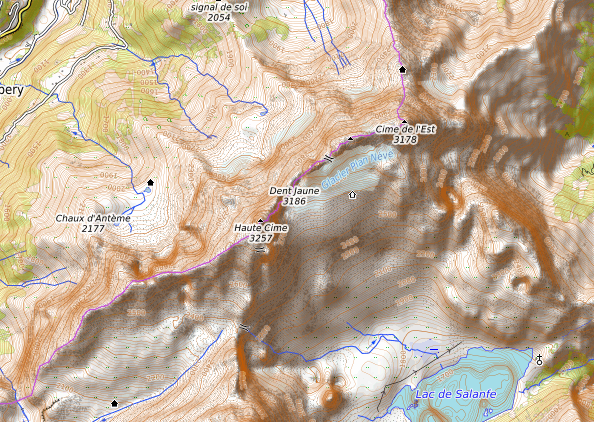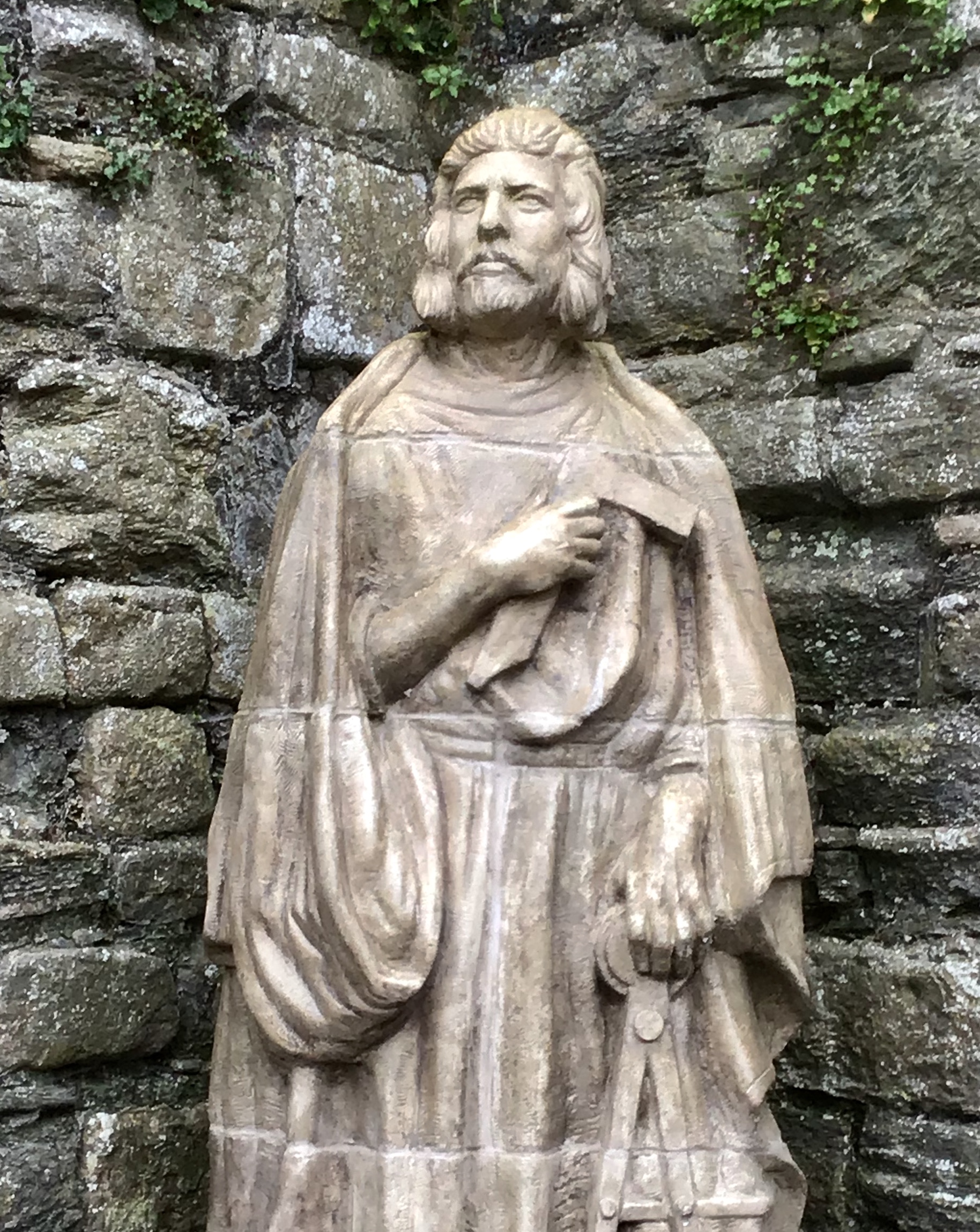|
Château De Chillon
Chillon Castle (, ) is a medieval island castle located on Lake Geneva, south of Veytaux in the Swiss canton of Vaud. It is situated at the eastern end of the lake, on the narrow shore between Montreux and Villeneuve, which gives access to the Alpine valley of the Rhône. Chillon is amongst the most visited medieval castles in Europe. Successively occupied by the House of Savoy, then by the Bernese from 1536 until 1798, it now belongs to the canton of Vaud and is classified as a Swiss Cultural Property of National Significance. Etymology According to the Swiss ethnologist Albert Samuel Gatschet, the name ''Chillon'' derives from the Waldensian dialect and means "flat stone, slab, platform". The name ''Castrum Quilonis'', attested from 1195, would, therefore, mean "castle built on a rock platform. Introduction The castle of Chillon is built on the island of Chillon, a small, steep-sided oval limestone rock that advances into Lake Geneva between Montreux and Villeneuve. ... [...More Info...] [...Related Items...] OR: [Wikipedia] [Google] [Baidu] |
Veytaux
Veytaux () is a municipality in the Riviera-Pays-d'Enhaut district in the canton of Vaud in Switzerland. The Château de Chillon across the Avenue de Chillon on Lake Geneva provides a view of the entire lake looking westward. History Veytaux is first mentioned in 1332 as ''Veytour''. Geography Veytaux has an area, , of . Of this area, or 14.5% is used for agricultural purposes, while or 74.0% is forested. Of the rest of the land, or 5.3% is settled (buildings or roads) and or 5.6% is unproductive land.Swiss Federal Statistical Office-Land Use Statistics 2009 data accessed 25 March 2010 Of the built up area, housing and buildings made up 2.2% and transportation infrastructure made up 2.2%. Out of the forested land, 70.9% of the total land area is ... [...More Info...] [...Related Items...] OR: [Wikipedia] [Google] [Baidu] |
Dents Du Midi
The Dents du Midi (; French language, French: "teeth of midday") are a three-kilometre-long mountain range in the Chablais Alps in the canton of Valais, Switzerland. Overlooking the Val d'Illiez and the Rhône valley to the south, they face the Lac de Salanfe, an artificial reservoir, and are part of the geological ensemble of the Giffre massif. Their seven peaks are, from north-east to south-west: the Cime de l'Est, the Forteresse, the Cathédrale, the Éperon, the Dent Jaune, the Doigts and the Haute Cime. They are mainly composed of limestone rock, with gritty limestone rock in the upper parts. The Dents du Midi are accessible from Champéry, les Cerniers, Mex, Valais, Mex, Salvan and Vérossaz, but they have only been Climbing, climbed since the end of the 18th century. A footpath around the Dents du Midi has existed since 1975. The mountain range represents a local symbol and is often used to promote the Val d'Illiez and various brands and associations in the region. Names T ... [...More Info...] [...Related Items...] OR: [Wikipedia] [Google] [Baidu] |
François De Bonivard
François () is a French masculine given name and surname, equivalent to the English name Francis. People with the given name * François Amoudruz (1926–2020), French resistance fighter * François-Marie Arouet (better known as Voltaire; 1694–1778), French Enlightenment writer, historian, and philosopher * François Beauchemin (born 1980), Canadian ice hockey player for the Anaheim Ducks * François Blanc (1806–1877), French entrepreneur and operator of casinos * François Bonlieu (1937–1973), French alpine skier * François Cevert (1944–1973), French racing driver * François Chau (born 1959), Cambodian American actor * François Clemmons (born 1945), American singer and actor * François Corbier (1944–2018), French television presenter and songwriter * François Coty (1874–1934), French perfumer * François Coulomb the Elder (1654–1717), French naval architect * François Coulomb the Younger (1691–1751), French naval architect * François Couperin (1668–17 ... [...More Info...] [...Related Items...] OR: [Wikipedia] [Google] [Baidu] |
James Of Saint George
Master James of Saint George (–1309; French: , Old French: Mestre Jaks, Latin">-4; we might wonder whether there's a point at which it's appropriate to talk of the beginnings of French, that is, when it wa ...: Mestre Jaks, Latin: Magister Jacobus de Sancto Georgio) was a master of works/architect from Savoy, described by historian Marc Morris as "one of the greatest architects of the European Middle Ages". He was largely responsible for designing King Edward I of England, Edward I's castles in North Wales, including Conwy, Harlech and Caernarfon (all begun in 1283) and Beaumaris on Anglesey (begun 1295). Origin and early life There is little firm documentary evidence of James’ early life and origin. Circumstantial evidence, however, suggests that his place of birth was Saint-Prex in or around the year 1230. His father was also an architect mason, named John. This strong evidence related to his father, including year of death and architectural style, lead to the conclus ... [...More Info...] [...Related Items...] OR: [Wikipedia] [Google] [Baidu] |
Peter II Of Savoy
Peter II (c. 120315 May 1268), called the Little Charlemagne, was Count of Savoy from 1263 until his death in 1268. He was also holder of the Honour of Richmond, Yorkshire in England, and the English lands of the Honour of the Eagle also known as the Honour of Pevensey and the Honour of Eu also known as the Honour of Hastings. His significant land holdings in the English County of Sussex were also marked by his holding of the wardship of John de Warenne, 6th Earl of Surrey which brought with it lands centred upon Lewes castle. Briefly, from 1241 until 1242, castellan of Dover Castle and Keeper of the Coast (later called Lord Warden of the Cinque Ports). In 1243 he was granted land by the River Thames on the Strand near the City of London, where he built the Savoy Palace.Marshall, John (2023). Peter of Savoy: The Little Charlemagne. Pen and Sword. Biography Early career in Savoy Peter was born around 1203, possibly at Susa, Piedmont. He was likely the seventh child of Thom ... [...More Info...] [...Related Items...] OR: [Wikipedia] [Google] [Baidu] |
Cistercians
The Cistercians (), officially the Order of Cistercians (, abbreviated as OCist or SOCist), are a Catholic religious order of monks and nuns that branched off from the Benedictines and follow the Rule of Saint Benedict, as well as the contributions of the highly influential Bernard of Clairvaux, known as the Latin Rule. They are also known as Bernardines, after Bernard of Clairvaux, Saint Bernard, or as White Monks, in reference to the colour of their cowl, as opposed to the black cowl worn by Benedictines. The term ''Cistercian'' derives from ''Cistercium,'' the Latin name for the locale of Cîteaux, near Dijon in eastern France. It was here that a group of Benedictine monks from the monastery of Molesme Abbey, Molesme founded Cîteaux Abbey in 1098. The first three abbots were Robert of Molesme, Alberic of Cîteaux and Stephen Harding. Bernard helped launch a new era when he entered the monastery in the early 1110s with 30 companions. By the end of the 12th century, the ord ... [...More Info...] [...Related Items...] OR: [Wikipedia] [Google] [Baidu] |
Humbert III, Count Of Savoy
Humbert III (1136 – 4 March 1189), surnamed the Blessed, was Count of Savoy from 1148 to 1189. His parents were Amadeus III of Savoy and Mahaut of Albon. He ceded rights and benefits to monasteries and played a decisive role in the organisation of Hautecombe Abbey. It is said that he would rather have been a monk than a sovereign. On the death of his third wife, he retired to Hautecombe, but then changed his mind and, by his fourth wife finally had a son, Thomas. He sided with the Guelph party of Pope Alexander III against the Ghibelline emperor Frederick Barbarossa. The result was an invasion of his states twice: in 1174 Susa was set on fire, and in 1187 Henry VI banished him from the Holy Roman Empire and wrested away most of his domains. He was left with only the valleys of Susa and Aosta. He died at Chambéry in 1189. He was the first prince buried at Hautecombe. His memorial day is 4 March. Early life Humbert III was born around 1136 in the castle of Avigliana, Piedmon ... [...More Info...] [...Related Items...] OR: [Wikipedia] [Google] [Baidu] |
Great Saint Bernard Pass
The Great St Bernard Pass (, , ; ) is the third highest road pass in Switzerland, at an elevation of . It connects Martigny in the canton of Valais in Switzerland with Aosta in the region Aosta Valley in Italy. It is the lowest pass lying on the ridge between the two highest mountains of the Alps, Mont Blanc and Monte Rosa. It is located on the main watershed that separates the basin of the Rhône from that of the Po. Great St Bernard is one of the most ancient passes through the Western Alps, with evidence of use as far back as the Bronze Age and surviving traces of a Roman road. In 1800, Napoleon's army used the pass to enter Italy, an event depicted in Jacques-Louis David's '' Napoleon at the Saint-Bernard Pass'' and Paul Delaroche's '' Bonaparte Crossing the Alps'', both notable oil paintings. Having been bypassed by easier and more practical routes, particularly the Great St Bernard Tunnel, a road tunnel which opened in 1964, its value today is mainly historical and ... [...More Info...] [...Related Items...] OR: [Wikipedia] [Google] [Baidu] |
Donjon
A keep is a type of fortified tower built within castles during the Middle Ages by European nobility. Scholars have debated the scope of the word ''keep'', but usually consider it to refer to large towers in castles that were fortified residences, used as a refuge of last resort should the rest of the castle fall to an adversary. The first keeps were made of timber and formed a key part of the motte-and-bailey castles that emerged in Normandy and County of Anjou, Anjou during the 10th century; the design spread to England, Portugal, south Italy and Sicily. As a result of the Norman Conquest of England in 1066, use spread into Wales during the second half of the 11th century and into Ireland in the 1170s. The Anglo-Normans and French rulers began to build stone keeps during the 10th and 11th centuries, including Norman keeps, with a square or rectangular design, and circular shell keeps. Stone keeps carried considerable political as well as military importance and could take a dec ... [...More Info...] [...Related Items...] OR: [Wikipedia] [Google] [Baidu] |
Middle Ages
In the history of Europe, the Middle Ages or medieval period lasted approximately from the 5th to the late 15th centuries, similarly to the post-classical period of global history. It began with the fall of the Western Roman Empire and transitioned into the Renaissance and the Age of Discovery. The Middle Ages is the middle period of the three traditional divisions of Western history: classical antiquity, the medieval period, and the modern period. The medieval period is itself subdivided into the Early, High, and Late Middle Ages. Population decline, counterurbanisation, the collapse of centralised authority, invasions, and mass migrations of tribes, which had begun in late antiquity, continued into the Early Middle Ages. The large-scale movements of the Migration Period, including various Germanic peoples, formed new kingdoms in what remained of the Western Roman Empire. In the 7th century, North Africa and the Middle East—once part of the Byzantine Empire� ... [...More Info...] [...Related Items...] OR: [Wikipedia] [Google] [Baidu] |





